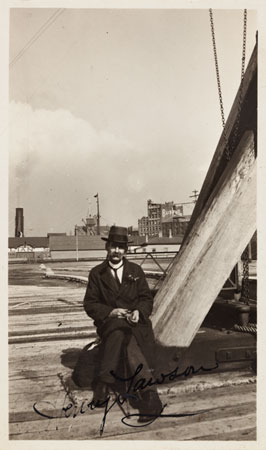Last days
 Henry Lawson on the Wharf, c.1922,
Henry Lawson on the Wharf, c.1922,photoprint by Phil Harris.
PXB 526/ 1
At his lowest point, Henry Lawson could be seen wandering the Sydney streets, begging for money. Everyone knew him from his works, but few would associate with him. John Le Gay Brereton, EJ Brady and George Robertson often came to his rescue, helping him out financially. Lawson also stayed with other friends for short respites from drinking but always returned to Mrs. Byers’ home at Abbotsford, NSW.
In 1916, his friends found him a position at Yanco, near Leeton, providing data for the Murrumbidgee Irrigation Scheme. This was a prohibition area. Lawson described it as the driest place he'd ever been but his health improved and he continued to produce work there which was well received.
Returning to Sydney he soon went back to his old ways. He had a small allowance from his publishers which was enough to sustain him and, in 1920, Lawson was granted a lifetime pension of £1 per week from the Commonwealth Literary Fund.
Suffering a brain haemorrhage on 14 July, 1921, Lawson continued to work, writing about his travels to London. At age 55 and still writing, Lawson died peacefully in his sleep at Abbotsford on 2 September 1922.
Accorded a state funeral two days later, Henry Lawson was the first non-official to be honoured in this way, and the service was attended by both the Premier of New South Wales, Jack Lang, and the Prime Minister of Australia, W.M. Hughes. He is buried at Waverley Cemetery, Sydney.
>See images and personal possessions relating to Lawson's last days
Lawson was survived by his wife, Bertha, son Jim and daughter, Bertha Louisa. By 1922, Bertha Louisa was working as a librarian at the Mitchell Library and, after the author's death, mother and daughter worked together to cement Lawson's reputation. Further proof that Lawson did not lack friends and admirers can be seen from the volume 'Henry Lawson by his mates' published nine years later.
Henry Lawson had achieved legendary status during his lifetime for both his literary work and bohemian ways and since his death his writings have remained enduringly popular with generations of Australians. Lawson remains one of Australia's most famous writers, a fact commemorated by the inclusion of his portrait on the Australian ten dollar note.